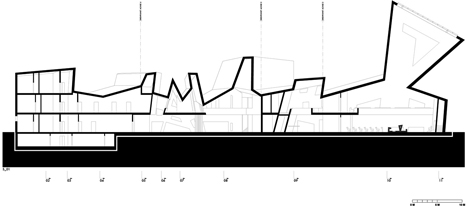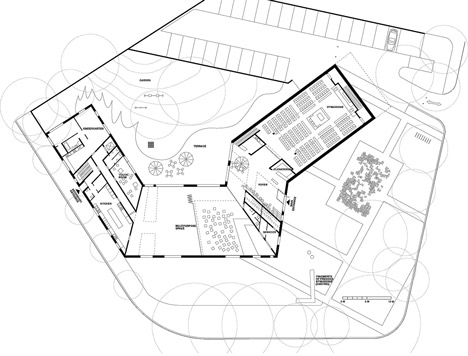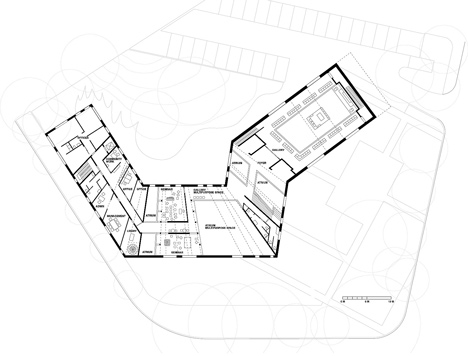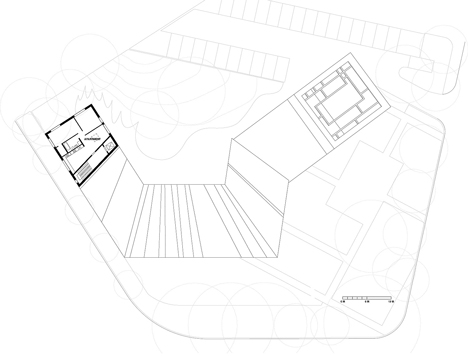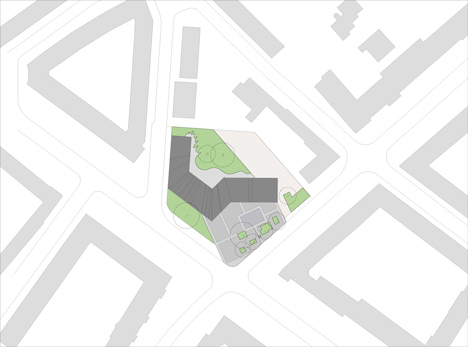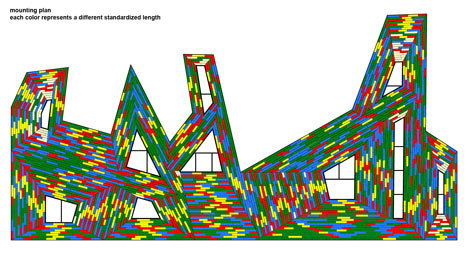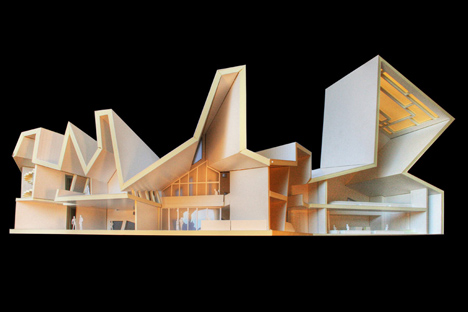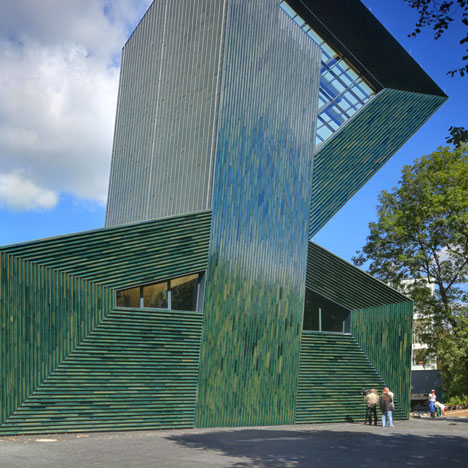
Mainz Jewish Community Center: הגולה מאור - Light of Mainz Diaspora
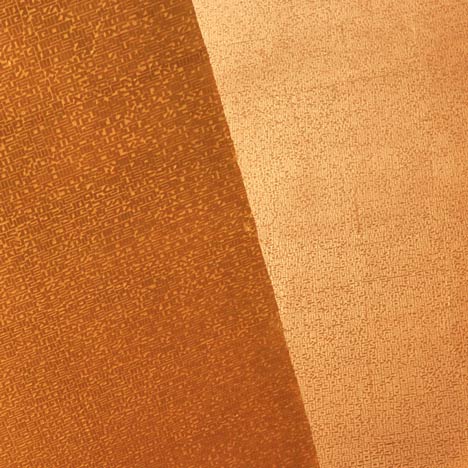
Manuel Herz Basel Architects have designed the Jewish Community Center in Mainz, Germany covered with green ceramic tiles.
Few Jewish communities to overcome Mainz in importance and tradition. During the Middle Ages, the main center of religious education, the importance goes back to a number of influential rabbis, especially Gershom ben Judah (960 to 1040), whose teachings and legal decisions that had an impact on Judaism in general. His wisdom was considered so great that he gave the name "מאור הגולה"
- "Light of the Diaspora. The new Jewish Community Center in Mainz try to extract this tradition.
The history of the Jews of Mainz, however, has also seen a different side. In almost any other city, Jews have been persecuted so often throughout history, and still have time and again tried to build a Jewish community-the community and in this city as seemingly serene Mainz.
From the first mention of the Jews' Magenza around 900 communities have been eradicated in a tragic regularity. And yet, a few years later Jews had the courage to settle again in Mainz.
Therefore, Mainz almost paradigmatically embodies the hope, learning and an unshakable belief in the future, and at the same time, the destruction of Jewish culture and people over more than a millennium.
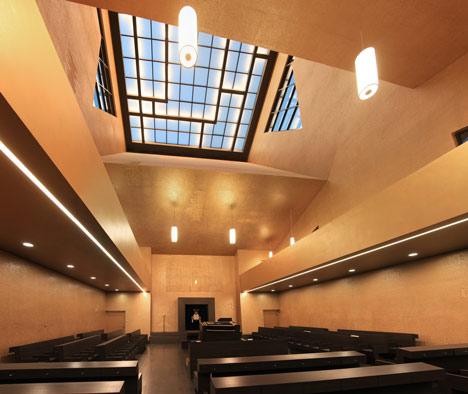
After the Holocaust, the community was founded again by a small group of Jews. Until the 1980 about 75 Jewish families living in Mainz when the immigration of Jews from the former Soviet republics increased this number by six. The spaces in a small residential building can not comply with the requirements of the growing community-the community for religious, social and cultural. A new building for a synagogue center of the community is necessary, built on the site of the former main 'Hindenburgstraße Synagogue.
The building and its urban context
The shape of the building is in the abstract based on the Hebrew word for blessing and curves around a public courtyard.
The center houses a synagogue, office space, meeting rooms, school multi-purpose space.
The interior walls are covered with dense synagogue Hebrew letters arranged in some areas in poetry by the rabbis of the 10th century.
In order to integrate the Jewish community center in the suburb of "Neustadt Mainzer, which dates from the late 19 th century, the" perimeter block pattern (Blockrandbebauung) dominant in the area is used as an urban concept. Volume the building is parallel to the street facades are in keeping with existing adjacent buildings, creating a contained space of the street. The use of urban figure pattern of the perimeter of the building blocks, very unusual for religious buildings , also questions the sacred position in the urban context. By the orientation of the building that houses the synagogue to the east two squares or open spaces are created: an indoor garden room that offers the community for recreation and celebration and a public plaza facing the main entrance facing the center of the city and provide an open space area within a densely developed urban fabric.
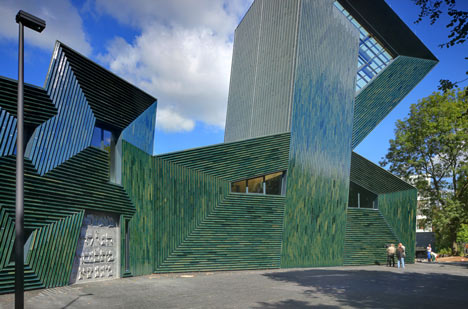
The absence of any barriers that block or means that this square has become a true public space that is used for daily activities by the public in general, rare for a religious building, especially for a synagogue in Germany.
The urban context is dominated by tall residential buildings of six to eight plants, which are characterized by a firm, solid. Since the program for the center of the synagogue and the community demands of its main functions are lo-ed on the ground floor, the building rises to great heights because of functional or territorial quality, otherwise it stays low.
This creates a volume that continually alternates between highs and lows, with the for-tion of a response to urban context. The precise articulation of this profile is informed by the subject of writing and its relation to space.
In its history Judaism has never developed a strong tradition of building. Nor has developed architectural styles, as is the case with other religions, trying to translate certain values and beliefs in the built environment. Instead, the writing can be seen as a replacement for the production space in Judaism. Specifically, the Talmud, written after the destruction of the Second Temple and the beginning of the Diaspora, can be seen as a response to the loss of Jerusalem as a central place in Judaism, and as an alternative spatial model. The dimension of architecture crosses throughout the Talmud, from the contents of individual chapters, through his method of writing, the techniques of argumentation-tion and discussion of the rabbis on their pages. At the level of words and letters, an object as expressed in the writings.
The Hebrew word for "word" (דבר - Davar) has the additional meaning of a thing or object. This quality of the writing subject and the concept of the Talmud (which found its central place of learning in the city of Mainz) and a notion of space in the design of a Jewish community center in Mainz.
Qadushah is the Hebrew word for raising and blessing, the five characters in an abstract way קדושה articulate the building's profile. With the pronouncement of a blessing an object is lifted profane or exalted. Rising from the everyday and becomes something special.
This is the special act of the building in daily use should be allowed. Glazed ceramic items facade to a different layer of writing and writing. Similar to a registration process or height of a wavy surface pattern and three-dimensional forms with ceramic tiles.
This pattern is arranged concentrically around the windows, creating a game-dimensional perspective. multiple perspectives to the windows of their vanishing points that arise in the building's facade. The spatial quality is enhanced by green transparent glass ceramic tiles, reflecting the changing light conditions of its environment and shows a wide range of hues and shades.
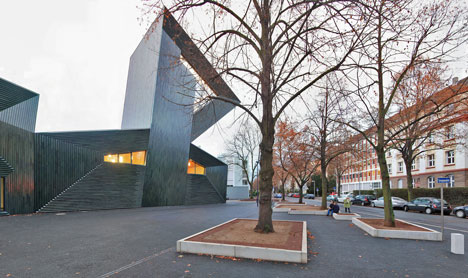
The synagogue is accessed through the main lobby. The organization of an area synagogue is usually characterized by some internal contradiction: on one hand synagogues are oriented and directed towards the east or Jerusalem.
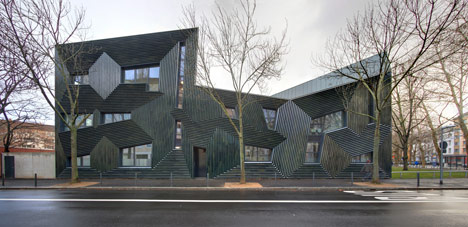
Moreover, as the Torah reading is done from a central position in space and in the midst of the community, the emphasis is on a centralized space. This inherent contradiction is spatially resolved by a horn-like roof which clearly indicates the area to the east, but with the right light in the center space, falling exactly in the position where we read the Bible. References horn 'shofar (ram's horn), back to avoid the sacrifice of Isaac by his father Abraham, symbolizes the connection and trust between mankind and the divine.
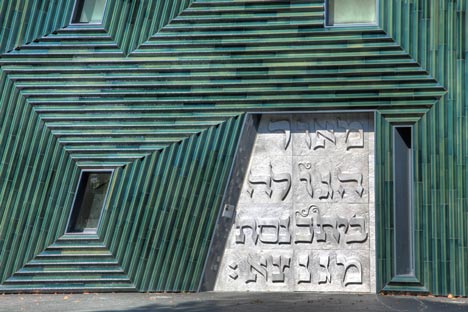
The interior surfaces are composed of dense synagogue Hebrew letters that form a relief in the form of mosaic, although the creation of semantic content. In some areas the density of points is reduced by rearranging the letters and the text is legible. 'Piyutim' (religious poetry) written by the rabbis of Mainz in the 10th century and 11 are carved into the surface of the synagogue. In an almost "Brechtian" language these Piyutim narrate the love of Torah, alluding to the 'Song of Songs "or the events surrounding the destruction of the community during the first crusades, and the reference of the central role Mainz to Judaism.
Moreover, the Jewish community center houses offices, classrooms and two apartments, and multipurpose space in the community.
This multipurpose space is the social and cultural heart of the community and used for internal purposes and for public events throughout the city.
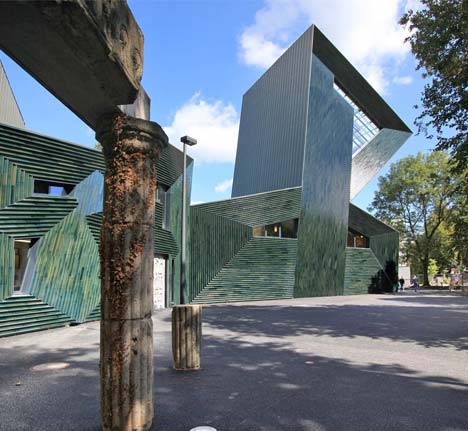
Community
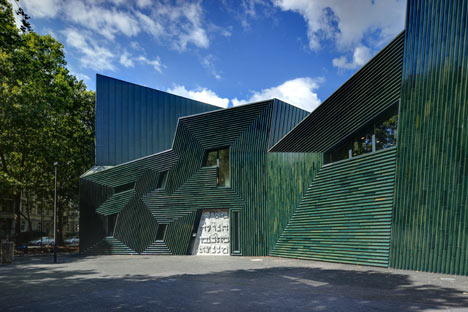 Jewish communities in Germany have been marked by a desire not to attract attention in their activities. They play a minor role in the social and cultural life of a city. This synagogue, in a city of one of the most important Jewish communities, is helping develop a different consciousness. The new synagogue is a building that, with the confidence of the marks of a new active site on a map of the city. It wants to attract city dwellers, Jews and non-Jews, to participate in religious activities, social and cultural rights. It is a building to call attention, maybe the questions, concerns, interests or perhaps even anger, but also hope. First is a building that will help the Jews of Mainz in a visible and active part of society and the link with its rich history. In Germany, a country where synagogues always have a political significance, this building shows the power of the Diaspora.
Jewish communities in Germany have been marked by a desire not to attract attention in their activities. They play a minor role in the social and cultural life of a city. This synagogue, in a city of one of the most important Jewish communities, is helping develop a different consciousness. The new synagogue is a building that, with the confidence of the marks of a new active site on a map of the city. It wants to attract city dwellers, Jews and non-Jews, to participate in religious activities, social and cultural rights. It is a building to call attention, maybe the questions, concerns, interests or perhaps even anger, but also hope. First is a building that will help the Jews of Mainz in a visible and active part of society and the link with its rich history. In Germany, a country where synagogues always have a political significance, this building shows the power of the Diaspora. on
Client: Project Team: Architect:
Project Management: Monitoring Site: Landscaping: Structural Engineering: Planning ceramic facade Electrical Engineering: Building Services: Building Physics:
Fire Services: Sound Planning: Total: Construction Cost: Completion:
Jewish community of Mainz Manuel Herz Architects, Basel and Cologne, Design Construction Manuel Herz: Elitsa Lacaze, Michalska Hania, Scheuvens Michael, Peter Sandmann, Design Concept: Cornelia Redeker, Sven Röttger, Sonja Klaus Mainzer Starke Aufbaugesellschaft Architekt Dittmar mbH, Mainz Harald Heims , Mainz Arup GmbH, Düsseldorf Keramikwerkstatt Niels Dietrich, Cologne K. Dörflinger GmbH, Allendorf Chamber of Engineers, Mainz IBC Ingenieurbau Consult GmbH, Ingenieurbüro Ingo Petry Mainz, Mainz Ingenieurgesellschaft für Technische Akustik, Wiesbaden approximately 2,500 square meters. 6.0 Mill. September 2010 Euro
